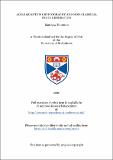Files in this item
Agile quantum cryptography and non-classical state generation
Item metadata
| dc.contributor.advisor | Korolkova, Natalia | |
| dc.contributor.author | Thornton, Matthew | |
| dc.coverage.spatial | xvi, 259 p. | en_US |
| dc.date.accessioned | 2021-02-03T07:00:34Z | |
| dc.date.available | 2021-02-03T07:00:34Z | |
| dc.date.issued | 2020-12-01 | |
| dc.identifier.uri | https://hdl.handle.net/10023/21361 | |
| dc.description.abstract | In the first half of this Thesis, we introduce a framework of “quantum cryptographic agility,” which allows for a resource-efficient swap of an underlying cryptographic protocol. Specifically, we introduce several schemes which perform the tasks of Digital Signatures and Secret Sharing. Our first achievement is an investigation of Quantum Digital Signatures (QDS) over a continuous-variables platform, consisting of phase-encoded coherent states and heterodyne phase detection. QDS allows for secure authentication of a classical message, while guaranteeing message transferability. For the first time, we prove security of CV QDS in the presence of an eavesdropper on the quantum channels. We then introduce a continuous variable (CV) Quantum Secret Sharing (QSS) protocol. Our security proof allows for classical information to be split and shared between multiple potentially dishonest recipients, while retaining security against collective beamsplitter and entangling-cloner attacks. In the last chapter of this half, we introduce another QDS scheme which runs over identical hardware setup to our QSS protocol. We analyse experimental data in which quantum coherent states were distributed at a rate of 1 GHz, which for QDS allows us to securely sign a message in less than 0.05 ms. In the second half of this Thesis we suggest and discuss a deterministic source of nonclassical light, which we call “PhoG”. Our source is based on the coherent diffusive photonics, relying on both coherent and dissipative evolution of the quantum state, and may be realised in an array of dissipatively-coupled laser-inscribed waveguides in a χ⁽³⁾ glass. We analyse the PhoG device with several analytical and numerical models and demonstrate that a coherent state input leads to a bright output state with strong photon-number squeezing. With minor reconfiguration our system can generate entanglement between spatially separated modes via a process analogous to four-wave mixing. | en_US |
| dc.language.iso | en | en_US |
| dc.publisher | University of St Andrews | |
| dc.relation | Agile quantum cryptography and non-classical state generation (thesis data) Thornton, M., University of St Andrews, 2020. DOI: https://doi.org/10.17630/6ba10862-4bdd-478f-8bd7-4f4b4d383374 | en |
| dc.relation.uri | https://doi.org/10.17630/6ba10862-4bdd-478f-8bd7-4f4b4d383374 | |
| dc.subject.lcsh | Cryptography | en |
| dc.subject.lcsh | Quantum theory | en |
| dc.title | Agile quantum cryptography and non-classical state generation | en_US |
| dc.type | Thesis | en_US |
| dc.contributor.sponsor | Engineering and Physical Sciences Research Council (EPSRC) | en_US |
| dc.type.qualificationlevel | Doctoral | en_US |
| dc.type.qualificationname | PhD Doctor of Philosophy | en_US |
| dc.publisher.institution | The University of St Andrews | en_US |
| dc.identifier.doi | https://doi.org/10.17630/sta/20 | |
| dc.identifier.grantnumber | 1798331 | en_US |
This item appears in the following Collection(s)
Items in the St Andrews Research Repository are protected by copyright, with all rights reserved, unless otherwise indicated.

